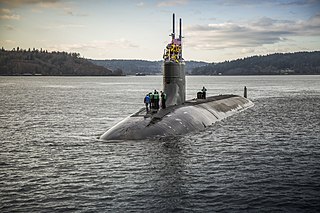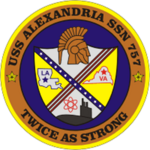
The Los Angeles class of submarines are nuclear-powered fast attack submarines (SSN) in service with the United States Navy. Also known as the 688 class after the hull number of lead vessel USS Los Angeles (SSN-688), 62 were built from 1972 to 1996, the latter 23 to an improved 688i standard. As of 2022, 26 of the Los Angeles class remain in commission—more than any other class in the world—and they account for more than half of the U.S. Navy's 50 fast attack submarines.

USS Augusta (SSN-710), a Los Angeles-class submarine, was the first ship of the United States Navy to be named for Augusta, Maine. The contract to build her was awarded to the Electric Boat Division of General Dynamics Corporation in Groton, Connecticut on 31 October 1973 and her keel was laid down on 1 April 1983. She was launched on 21 January 1984 sponsored by Mrs. Diana D. Cohen, wife of U.S. Senator William Cohen and commissioned on 19 January 1985.

USS Annapolis (SSN-760), is the tenth "improved" Los Angeles-class submarine. Annapolis is the fourth ship of the United States Navy to be named for Annapolis, Maryland, site of the United States Naval Academy.

USS Nautilus (SSN-571) was the world's first operational nuclear-powered submarine and the first submarine to complete a submerged transit of the North Pole on 3 August 1958. Her initial commanding officer was Eugene "Dennis" Wilkinson, a widely respected naval officer who set the stage for many of the protocols of today's Nuclear Navy of the US, and who had a storied career during military service and afterwards.

USS Scorpion (SSN-589) was a Skipjack-class nuclear-powered submarine that served in the United States Navy, and the sixth vessel, and second submarine, of the U.S. Navy to carry that name.

USS Hartford (SSN-768), a Los Angeles-class submarine, is the second ship of the Navy to be named for Hartford, Connecticut. The contract to build her was awarded to the Electric Boat Division of General Dynamics Corporation in Groton, Connecticut on 30 June 1988 and her keel was laid down on 22 February 1992. She was launched on 4 December 1993 sponsored by Laura O'Keefe, wife of former Secretary of the Navy Sean O'Keefe, and commissioned on 10 December 1994, with Commander George Kasten in command.

USS Montpelier (SSN-765), a Los Angeles-class submarine, is the third ship of the United States Navy to be named for Montpelier, Vermont. The contract to build her was awarded to Newport News Shipbuilding and Dry Dock Company in Newport News, Virginia on 6 February 1987 and her keel was laid down on 19 May 1989. She was christened 6 April 1991, launched on 23 August 1991 sponsored by Mrs. Nancy Hayes Sununu, and commissioned on 13 March 1993 with Commander Victor Fiebig in command.

Naval Station Norfolk is a United States Navy base in Norfolk, Virginia, that is the headquarters and home port of the U.S. Navy's Fleet Forces Command. The installation occupies about 4 miles (6.4 km) of waterfront space and 11 miles (18 km) of pier and wharf space of the Hampton Roads peninsula known as Sewell's Point. It is the world's largest naval station, with the largest concentration of U.S. Navy forces through 75 ships alongside 14 piers and with 134 aircraft and 11 aircraft hangars at the adjacently operated Chambers Field. Port Services controls more than 3,100 ships' movements annually as they arrive and depart their berths.

USS Connecticut (SSN-22) is a Seawolf-class nuclear powered fast attack submarine operated by the United States Navy. Connecticut is the fifth active United States Ship to be named for the U.S. state of Connecticut, going back to 1776. The contract to build her was awarded to the Electric Boat Division of General Dynamics Corporation in Groton, Connecticut, on 3 May 1991 and her keel was laid down on 14 September 1992. She was launched on 1 September 1997, sponsored by Patricia L. Rowland, wife of the Governor of Connecticut, John G. Rowland, and commissioned on 11 December 1998.

USS Woodrow Wilson (SSBN-624), a Lafayette class ballistic missile submarine, was the only ship of the United States Navy to be named for Woodrow Wilson (1856–1924), the 28th President of the United States (1913–1921). She later was converted into an attack submarine and redesignated SSN-624.

USS Sturgeon (SSN-637), was the lead ship of her class of nuclear-powered attack submarines. She was the third ship of the United States Navy to be named for the sturgeon.

USS Spadefish (SSN-668), a Sturgeon-class submarine, was the second ship of the United States Navy to be named for the spadefish, a spiny-finned fish found in coastal waters of the western Atlantic from Cuba to Cape Cod.

USS Lapon (SSN-661), a Sturgeon-class attack submarine, was the second ship of the United States Navy to be named for the lapon, a scorpionfish of the Pacific coast of North America.

USS Philadelphia (SSN-690), a Los Angeles-class attack submarine, was the sixth ship of the United States Navy to be named for the city of Philadelphia.

USS Pasadena (SSN-752) is a Los Angeles-class submarine and the third ship of the United States Navy to be named for Pasadena, California.

USS Columbus (SSN-762) is a Los Angeles-class nuclear powered fast attack submarine and the second vessel of the United States Navy to be named for Columbus, Ohio. The contract to build her was awarded to the Electric Boat Division of General Dynamics Corporation in Groton, Connecticut, on 21 March 1986 and her keel was laid down on 9 January 1991. She was launched on 1 August 1992 sponsored by Mrs. Margaret DeMars, wife of Admiral Bruce DeMars and commissioned on 24 July 1993.

Naval Base Point Loma (NBPL) is located in Point Loma, a neighborhood of San Diego, California. It was established on 1 October 1998 when Navy facilities in the Point Loma area of San Diego were consolidated under Commander, Navy Region Southwest. Naval Base Point Loma consists of seven facilities: Submarine Base, Naval Mine and Anti-Submarine Warfare Command, Fleet Combat Training Center Pacific, Naval Information Warfare Systems Command (NAVWAR), Naval Information Warfare Center (NIWC) Pacific, the Fleet Intelligence Command Pacific and Naval Consolidated Brig, Miramar. These close-knit commands form a diverse and highly technical hub of naval activity. The on-base population is around 22,000 Navy and civilian personnel.

The Commander, Submarine Force, U.S. Pacific Fleet (COMSUBPAC) is the principal advisor to the Commander, United States Pacific Fleet (COMPACFLT) for submarine matters. The Pacific Submarine Force (SUBPAC) includes attack, ballistic missile and auxiliary submarines, submarine tenders, floating submarine docks, deep submergence vehicles and submarine rescue vehicles throughout the Pacific.

USNS Sioux (T-ATF-171) was a United States Navy Powhatan-class tugboat operated by the Military Sealift Command (MSC). She was in service from 1981 to 2021 and spent the bulk of this time supporting the Pacific Fleet.

Summer Pulse 2004 (SP04) was the codename for a worldwide surge deployment that served as the first full-scale test of the United States Navy's then-new Fleet Response Plan (FRP). During Summer Pulse 2004, a total of seven carrier strike groups were underway at the same time in five different Numbered fleet areas of responsibility. This number of underway carrier strike groups had not been matched since the six carrier battle groups deployed during Operation Desert Storm. In addition to the carriers, the Navy also deployed 17 submarines and one submarine tender.























